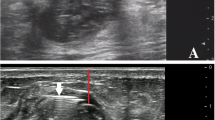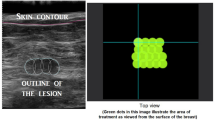Abstract
Objectives
To evaluate the clinical efficacy of microwave ablation (MWA) of benign breast lesions (BBLs) and compare the learning curves of international radiologists (IRs) and surgeons.
Methods
In total, 440 patients with 755 clinicopathologically confirmed BBLs from 5 centers were prospectively enrolled from February 2014 to July 2018. Technical success, complications, volume reduction ratio (VRR), palpability, and cosmetic satisfaction after ablation were analyzed. In addition, the ablation time (AT) and energy (AE) with the number of procedures were analyzed for learning curve evaluation.
Results
The mean maximum diameter was 1.7 ± 0.6 cm. The complete ablation rate reached 100%, including 45.8% lesions adjacent to the skin, pectoralis, or areola. After a median follow-up of 13.7 months, the 12-month VRR of all lesions was 97.9%, and that for 1.0- to 2.0-cm and ≥ 2.0-cm lesions was 98.6% and 96.9%, respectively. A total of 55.9% of BBLs became nonpalpable (palpable in 85.7% of cases before MWA) by both the clinician and patient. The cosmetic and minimally invasive satisfaction rates were good or excellent in 98.4% and 94.5% of patients, respectively. The median AT/cm3 and AE/cm3 decreased as experience increased. The AE/cm3 of the IR with 5 years of experience was lower than that of the IR with 1 year of experience and the surgeons, while the AT/cm3 of surgeons was comparable with that of the IR with 5 years of experience at relatively mature phase.
Conclusions
Ultrasound-guided percutaneous MWA is a valuable technique for the treatment of BBLs.
Trial registration: ClinicalTrials.gov (NCT02860104)
Key Points
• Ultrasound-guided percutaneous microwave ablation has the potential to become a valuable technique for the treatment of benign breast lesions.
• A skilled interventional radiologist shows a rapid improvement in mastering the technique.





Similar content being viewed by others
Abbreviations
- AE:
-
Ablation energy
- AP:
-
Ablation power
- AT:
-
Ablation time
- BBL:
-
Benign breast lesion
- BI-RADS:
-
Breast Imaging Recording and Data System
- CEMRI:
-
Contrast-enhanced magnetic resonance imaging
- CEUS:
-
Contrast-enhanced US
- IR:
-
Interventional radiologist
- LC:
-
Learning curve
- MWA:
-
Microwave ablation
- US:
-
Ultrasound
- VRR:
-
Volume reduction ratio
References
Salamat F, Niakan B, Keshtkar A, Rafiei E, Zendehdel M (2018) Subtypes of benign breast disease as a risk factor of breast cancer: a systematic review and meta analyses. Iran J Med Sci 43(4):355–364
Greenberg R, Skornick Y, Kaplan O (1998) Management of breast fibroadenomas. J Gen Intern Med 13(9):640–645
Paepke S, Metz S, Brea SA, Ohlinger R (2018) Benign breast tumours-diagnosis and management. Breast Care (Basel) 13(6):403–412
American College of Obstetricians and Gynecologists’ Committee on Practice Bulletins—Gynecology (2016) Practice bulletin no. 164: diagnosis and management of benign breast disorders. Obstet Gynecol 127(6):e141–e156
Hartmann LC, Sellers TA, Frost MH et al (2005) Benign breast disease and the risk of breast cancer. N Engl J Med 353(3):229–237
Lakoma A, Kim ES (2014) Minimally invasive surgical management of benign breast lesions. Gland Surg 3(2):142–148
Kaufman CS, Bachman B, Littrup PJ et al (2004) Cryoablation treatment of benign breast lesions with 12-month follow-up. Am J Surg 188(4):340–348
Cavallo MB, Pediconi F, Anzidei M et al (2015) High-intensity focused ultrasound in breast pathology: non-invasive treatment of benign and malignant lesions. Expert Rev Med Devices 12(2):191–199
Grady I, Gorsuch H, Wilburn-Bailey S (2008) Long-term outcome of benign fibroadenomas treated by ultrasound-guided percutaneous excision. Breast J 14(3):275–278
Yu J, Liang P, Yu X, Liu F, Chen L, Wang Y (2011) A comparison of microwave ablation and bipolar radiofrequency ablation both with an internally cooled probe: results in ex vivo and in vivo porcine livers. Eur J Radiol 79(1):124–130
Tanaka T, Westphal S, Isfort P et al (2012) Microwave ablation compared with radiofrequency ablation for breast tissue in an ex vivo bovine udder model. Cardiovasc Intervent Radiol 35(4):914–920
Zhang W, Jin ZQ, Baikpour M et al (2019) Clinical application of ultrasound-guided percutaneous microwave ablation for benign breast lesions: a prospective study. BMC Cancer 19(1):345
Xu J, Wu H, Han Z et al (2018) Microwave ablation of benign breast tumors: a prospective study with minimum 12 months follow-up. Int J Hyperthermia 35(1):253–261
Yu J, Chen B, Zhang J et al (2017) Ultrasound guided percutaneous microwave ablation of benign breast lesions. Oncotarget 8(45):79376–79386
Li C, Li C, Ge H et al (2018) Technical analysis of US imaging for precise microwave ablation for benign breast tumours. Int J Hyperthermia 34(8):1179–1185
Xu J, Cao Y, Xu C et al (2017) Combination of microbubbles and diagnostic ultrasound at a high mechanical index for the synergistic microwave ablation of tumours. Int J Hyperthermia 33(3):318–326
Ahmed M, Solbiati L, Brace CL et al (2014) Image-guided tumor ablation: standardization of terminology and reporting criteria--a 10-year update. Radiology 273(1):241–260
Cardella JF, Miller DL, Cole PE, Lewis CA (2003) Society of Interventional Radiology position statement on radiation safety. J Vasc Interv Radiol 14(9 Pt 2):S387
Thibault R, Goujon N, Le Gallic E et al (2009) Use of 10-point analogue scales to estimate dietary intake: a prospective study in patients nutritionally at-risk. Clin Nutr 28(2):134–140
Zhou W, Wang R, Liu X et al (2017) Ultrasound-guided microwave ablation: a promising tool in management of benign breast tumours. Int J Hyperthermia 33(3):263–270
Yang BR, Kim HJ, Shin KM et al (2015) Serial ultrasound findings after laser ablation for benign breast lesions on long-term follow-up: implications for evaluation of procedural success. Photomed Laser Surg 33(8):404–408
Kovatcheva R, Guglielmina JN, Abehsera M, Boulanger L, Laurent N, Poncelet E (2015) Ultrasound-guided high-intensity focused ultrasound treatment of breast fibroadenoma-a multicenter experience. J Ther Ultrasound 3(1):1
Sag AA, Maybody M, Comstock C, Solomon SB (2014) Percutaneous image-guided ablation of breast tumors: an overview. Semin Intervent Radiol 31(2):193–202
Fornage BD, Hwang RF (2014) Current status of imaging-guided percutaneous ablation of breast cancer. AJR Am J Roentgenol 203(2):442–448
Marcy PY, Magné N, Castadot P, Bailet C, Namer M (2007) Ultrasound-guided percutaneous radiofrequency ablation in elderly breast cancer patients: preliminary institutional experience. Br J Radiol 80(952):267–273
Mauri G, Sconfienza LM, Pescatori LC et al (2017) Technical success, technique efficacy and complications of minimally-invasive imaging-guided percutaneous ablation procedures of breast cancer: a systematic review and meta-analysis. Eur Radiol 27(8):3199–3210
García-Tejedor A, Guma A, Soler T et al (2018) Radiofrequency ablation followed by surgical excision versus lumpectomy for early stage breast cancer: a randomized phase II clinical trial. Radiology 289(2):317–324
Yu J, Wu H, Meng XW et al (2019) Ultrasound-guided percutaneous microwave ablation of central intraductal papilloma: a prospective pilot study. Int J Hyperthermia 36(1):606–612
Takei H, Iino Y, Horiguchi J et al (1999) Natural history of fibroadenomas based on the correlation between size and patient age. Jpn J Clin Oncol 29(1):8–10
Orr B, Kelley JL 3rd (2016) Benign breast diseases: evaluation and management. Clin Obstet Gynecol 59(4):710–726
Dixon JM, Dobie V, Lamb J, Walsh JS, Chetty U (1996) Assessment of the acceptability of conservative management of fibroadenoma of the breast. Br J Surg 83(2):264–265
Acknowledgments
We thank the participants and staff of the Department of Interventional Ultrasound, Chinese PLA General Hospital, for their valuable contributions.
Funding
This work was supported by Grant JQ18021 from the National Scientific Foundation Committee of Beijing; Grants 81627803, 81971625, and 91859201 from the National Scientific Foundation Committee of China, Fostering Funds for National Distinguished Young Scholar Science Fund, and the National Clinical Research Center for Geriatric Diseases (NCRCG-PLAGH-2019011) of Chinese PLA General Hospital; and Grant 2018ZX10723-204 from the National Key R&D Program of Ministry of Science and Technology of China.
Author information
Authors and Affiliations
Corresponding authors
Ethics declarations
Guarantor
The scientific guarantor of this publication is Ping Liang and Jie Yu.
Conflict of interest
The authors of this manuscript declare no relationships with any companies whose products or services may be related to the subject matter of the article.
Statistics and biometry
No complex statistical methods were necessary for this paper.
Informed consent
Written informed consent was obtained from all subjects (patients) in this study.
Ethical approval
Institutional Review Board approval was obtained.
Study subjects or cohorts overlap
Some study subjects or cohorts have been previously reported in Oncotarget and International Journal of Hyperthermia.
Methodology
• Prospective
• Observational
• Multicenter study
Additional information
Publisher’s note
Springer Nature remains neutral with regard to jurisdictional claims in published maps and institutional affiliations.
Electronic supplementary material
ESM 1
(DOC 20847 kb)
Rights and permissions
About this article
Cite this article
Yang, Q., Li, H., Chen, Bh. et al. Ultrasound-guided percutaneous microwave ablation for 755 benign breast lesions: a prospective multicenter study. Eur Radiol 30, 5029–5038 (2020). https://doi.org/10.1007/s00330-020-06868-9
Received:
Revised:
Accepted:
Published:
Issue Date:
DOI: https://doi.org/10.1007/s00330-020-06868-9




